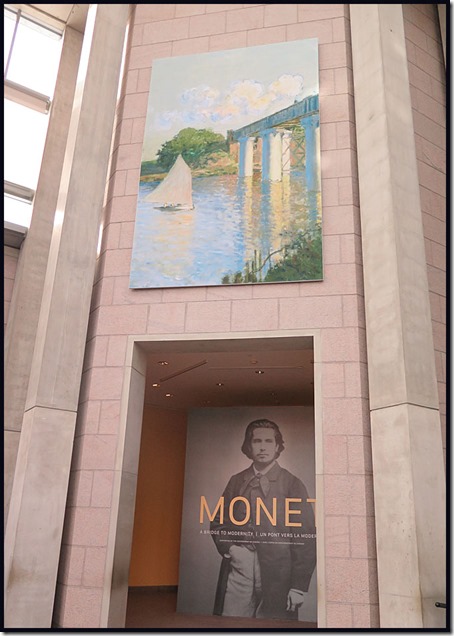It was too cold to ski, so we enjoyed a short stroll by the River Rideau, accessed from our doorstep. Few pictures (2) were taken as frostbite was a serious risk if gloves were removed for more than a few seconds.
It was a lovely sunny day though.
The underground car park at the National Gallery of Canada enabled us to avoid the frost and visit the gallery, a favourite spot. We drove alongside the Rideau Canal, the longest skating rink in the world, to get there. There were a few hardy souls on the ice.
The gallery building is magnificent, and the Monet exhibition was interesting.
We also visited the rooms housing the work of the Group of Seven, a group of Canadian landscape artists whose work between 1920 and 1933 has earned them much acclaim. It’s good to see the originals of some of the prints in Ken and Helen’s house.
Here’s more on the Monet Exhibition:
About the Exhibition
Claude Monet (1840–1926), one of the most renowned and beloved French Impressionist painters, is celebrated for his seemingly fleeting impressions of the natural world. While he has been hailed as the plein-air painter par excellence, his art is not, however, as spontaneous as it may first appear.
Monet: A Bridge to Modernity is the first monographic exhibition in Canada devoted to the artist in almost two decades. Here, the National Gallery of Canada brings together twelve seminal works from collections around the world that highlight Monet’s methodical approach through his innovative experiments with the motif of the bridge. He did not simply paint what he saw; rather, he was an astute and deliberate artist who used this motif as a laboratory for working out his painterly technique and aesthetic ideas.
Monet painted these works during his stay in Argenteuil, a bustling suburb of Paris where he settled in late 1871 after his self-imposed exile in London and Holland during the Franco-Prussian War (1870–71). Upon his arrival in the small town Monet became fascinated with the local highway and railway bridges, repeatedly returning to this subject. In his important early work Le pont de bois (1872), currently on long-term loan to the Gallery, he depicts the highway bridge under repair following the destruction wrought by the war – a tribute to France’s return to order. With a cropped view and flattened perspective reminiscent of Japanese woodblock prints, Monet frames the river basin with the wooden structure of the bridge and the scaffolding, effectively creating a picture within a picture frame. This daring composition, in which the artist demonstrates a conscious interest in “picture-making,” became the point of departure for similar explorations of the bridge theme, each with a different viewpoint, technique, colour and brushwork. What resulted were paintings of startling modernity that cemented Monet’s status as one of the leaders of the nineteenth-century French avant-garde.
This focus exhibition casts new light on Le pont de bois as it delves into the historic, sociological and artistic context of the early years of Impressionism in the early 1870s. The twelve paintings on view are accompanied by a collection of nineteenth-century photographs, illustrations, guide books, Japanese prints and postcards. A truly immersive experience, Monet: A Bridge to Modernity provides a fresh view of some of the Impressionist’s most treasured works from a pivotal period in his career.
❧
Monet’s talent… in my opinion is very serious and very pure… it is a highly conscious art, based upon observation and derived from a completely new feeling; it is poetry through the harmony of true colours…
Camille Pissarro, 1873
❧
Claude Monet, The Bridge at Argenteuil, 1874, oil on canvas, 89.8 × 81.4 cm. Neue Pinakothek, Munich. 1912 Tschudi Contribution. Photo © Neue Pinakothek / Art Resource, NY
Claude Monet: The Argenteuil Years
Monet’s stay in Argenteuil, from late 1871 to 1878, marked a critical period in his career. Thirty-one-years-old, newly married and with a young son, he returned to France after the Franco-Prussian War and settled in the Parisian suburb near the banks of the Seine, embarking on a period of intense creativity during which he developed his powers of observation and visual analysis and refined his distinctive approach to landscape painting. In his first year at Argenteuil, Monet produced almost as many works as he did in the three years prior, painting the town’s busy streets and buildings, vine-covered hillsides, his own family in their rented house and garden, and the rippling Seine with its modern bridges. Until the end of 1873 the dealer Paul Durand-Ruel purchased Monet’s works nearly as fast as he could paint them, granting the artist a measure of financial success for the first time in his career.
Monet’s colleagues, including Alfred Sisley, Édouard Manet and Pierre-Auguste Renoir, would often join him in Argenteuil, painting together and benefitting from one another in the process. Monet also played an important role in organizing the first of eight exhibitions of the “Société anonyme des artistes, peintres, sculpteurs, graveurs, etc.” in April 1874 in Paris, where the artist’s Impression Sunrise (1872) garnered much attention. Monet’s paintings of the Argenteuil bridges, executed during these momentous years surrounding the birth of the Impressionist movement, are among the most experimental and innovative compositions in his early career.
Claude Monet, The Port at Argenteuil, c. 1872, oil on canvas, 60 × 80.5 cm. Musée d’Orsay, Paris. Photo: Hervé Lewandowski. © RMN-Grand Palais / Art Resource, NY







2 comments:
Lucky ducks, love Monet.
Yes Louise, our timing was immaculate - the exhibition ended this week.
Post a Comment